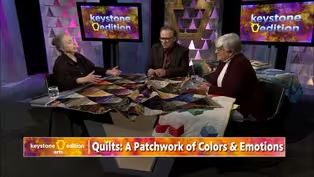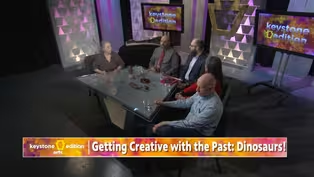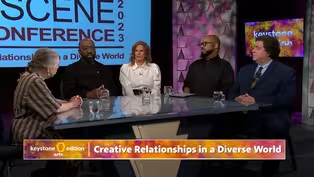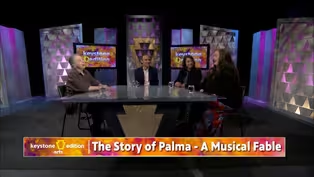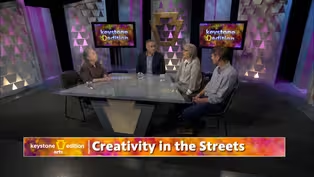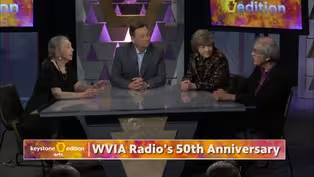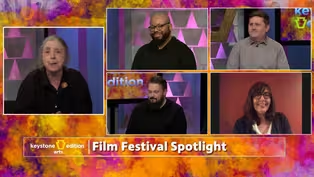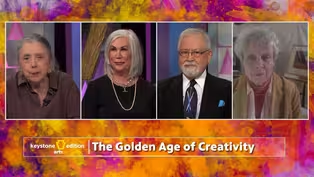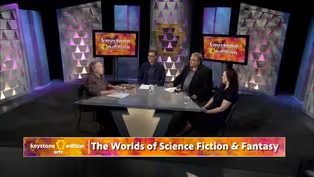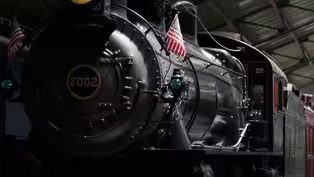Keystone Edition
Trains!
12/19/2022 | 27mVideo has Closed Captions
Trains played an essential role in Pennsylvania's history and continue to fascinate today.
All aboard! Trains played an essential role in Pennsylvania's history and continue to fascinate today. Keystone Edition: Arts explores how and why trains fuel the imagination of some of the region's artists.
Problems playing video? | Closed Captioning Feedback
Problems playing video? | Closed Captioning Feedback
Keystone Edition is a local public television program presented by WVIA
Keystone Edition
Trains!
12/19/2022 | 27mVideo has Closed Captions
All aboard! Trains played an essential role in Pennsylvania's history and continue to fascinate today. Keystone Edition: Arts explores how and why trains fuel the imagination of some of the region's artists.
Problems playing video? | Closed Captioning Feedback
How to Watch Keystone Edition
Keystone Edition is available to stream on pbs.org and the free PBS App, available on iPhone, Apple TV, Android TV, Android smartphones, Amazon Fire TV, Amazon Fire Tablet, Roku, Samsung Smart TV, and Vizio.
Providing Support for PBS.org
Learn Moreabout PBS online sponsorshipMore from This Collection
Witness first-hand the creativity of Northeastern and Central Pennsylvania as WVIA Radio Program Manager and afternoon classical music host, Erika Funke interviews area artists, musicians, performers, authors, and more each month.
Quilts: A Patchwork of Colors and Emotions
Video has Closed Captions
Quilts keep us more than just warm; they convey stories of family and cultural heritage. (26m 59s)
Video has Closed Captions
We invite you to learn about our region's past and present illustrators. (26m 59s)
Getting Creative with the Past: Dinosaurs!
Video has Closed Captions
What can we can learn by digging into the past with a creative mindset? (26m 59s)
Creative Relationships in a Diverse World
Video has Closed Captions
Creative Relationships in a Diverse World (54m 59s)
The Story of Palma - A Musical Fable
Video has Closed Captions
Get a behind-the-scenes look at the production (26m 59s)
Video has Closed Captions
Keystone Edition: Arts explores the past and present of the region’s murals (26m 59s)
Video has Closed Captions
We'll ask the WVIA radio hosts to share favorite memories (54m 59s)
Video has Closed Captions
We ask regional film festivals how they choose and what we can learn about filmmaking (26m 59s)
Playing Around: Sports and the Arts!
Video has Closed Captions
Keystone Edition: Arts asks what we learn when we look at sports through a creative lens. (26m 59s)
Video has Closed Captions
What changes for artists as they age? What benefits come from being creative while aging? (26m 59s)
Inclusivity and Diversity in the Theatre
Video has Closed Captions
How can theatre companies attract more diverse cast members and audiences? (26m 59s)
The Worlds of Science Fiction and Fantasy
Video has Closed Captions
PA has long been home to science fiction & fantasy writers & artists. (27m)
Providing Support for PBS.org
Learn Moreabout PBS online sponsorship(upbeat ambient music) - Live from your public media studios WVIA presents Keystone Edition Arts, a public affairs program that goes beyond the headlines to address issues in Northeastern and central Pennsylvania.
This is Keystone Edition Arts.
And now Erica Funke.
- Welcome to Keystone Edition Arts where we'll take a fresh look at trains.
Paul Lazar gets us on the right track.
- [Paul] In the early 1900s, traveling by train often resulted in soot covered clothes due to the wood and bituminous coal powered steam engine.
Lackawanna Railroad used anthracite coal in their passenger locomotives, which produced less soot when burned.
To promote this benefit, the railroad company turned to Ernest Elmo Calkins who advocated the integration of design elements artistic qualities, and literary features.
Calkins and his agency created Phoebe Snow, one of the earliest fictional characters in advertising.
She was depicted as a young woman dressed in white, showing that train travelers didn't have to endure dirty clothing.
The ads included rhyming verses like "And Phoebe knows that smoke and cinders spoil good clothes, is thus a pleasure and delight to take the road of anthracite."
After World War I, the railroad used the Phoebe Snow name and image to promote traveling by train for summer and winter vacations in the Poconos.
In 1949, the Phoebe Snow passenger train continued the legacy of clean train travel, now using diesel engines.
And Phoebe Snow lives on in composer Julia Wolfe's anthracite fields, and Oratorio that describes coal mining life in Pennsylvania in the early 20th century.
The Oratorio premiered in 2014, over 100 years after Phoebe Snow first appeared in ads.
For Keystone Edition Arts, I'm Paul Lazar - Thanks Paul.
And also to Patrick McKnight, an historian, an archivist at Steamtown National Historic site in Scranton for sharing those images and information from their collection on Phoebe Snow.
Turns out, the very same railroad company that recognized the value of the graphic arts in promoting its name through images of Phoebe Snow up the ante.
The president of the Delaware, Lackawanna and Western Railroad commissioned the superb American landscape painter, George Inness to celebrate the company's big new roundhouse in Scranton, the painting titled "The Lackawanna Valley" is part of the collection of the National Gallery of Art in Washington DC and it's become a touchstone of 19th century works in which the worlds of industry and nature meet.
It's not exactly a love letter to the notion of progress, just look at the sea of tree stumps front and center as the train approaches.
But what about that young fellow in the lower left?
He's lying on the ground propped up on his elbow, and it seems his sights are set on the advancing steam locomotive.
For Inness, he might represent people's fascination with the sights and sounds of the new technology A red vested viewer whose life will be changed in good and bad ways by the mighty iron horse moving ever closer.
We have, as our guests two distinctive artists who've set their sights on trains and on what trains have meant to us as Americans.
Oren Helbok of Bloomsburg is an award-winning photographer who's tracked train since he was a lad.
He's a master of his art, an essayist and quite a wonderful storyteller.
Angela Trotta Thomas hails from Lackawanna County, though she relocated to Charleston, South Carolina a while back.
She received a master's degree in studio art from Marywood University and has spent the past 40 plus years as an illustrator and fine artist, going on to become the premier Lionel Toy Train artist in America.
Welcome, Angela.
Tell us about you and trains.
We know for many years, trains and kids were boys concerns.
How did you first meet up with a model train set, and what was it about toys trains that attracted you enough to want to paint them?
- Well, it all started about 32 years ago.
I was working on a master's research project for Mary Wood University with their program, "Get Your Masters With the Masters".
And part of that program was to do a research project.
So I had two small children at the time, and was trying to figure out how I was gonna fit all this in.
Anyway, make a long story short, my husband who was an avid Lionel collector for years and years, and he has a very large collection of trains, and the old Lionel catalogs started showing me the artwork that was done in all the old Lionel catalogs.
And it was so beautiful, they were so beautifully illustrated and such evocative imagery for children to want to be that engineer for that layout.
And I just was very intrigued.
So that's how I got started.
And my husband being such an avid collector and loving trains said, "I'll help you".
So I thought, "Well, you know what?
That's really gonna work well for me right now."
So basically that's how I got started.
I worked on the project.
Little did I know that it would become my life's work, which it has because I've been now with Lionel for 31 years.
I'm wanna say hello to my granddaughter Rhett, who is now six.
And when her father was six years old, he was my first model for all my Lionel train pieces.
So it's been a full generation of models and trains, and I've watched the nostalgia of the trains hold through, Lionel is 123 years old now.
And the memories and the emotional attachments to these toys is what I think has held it together for this many years.
And that's what I paint, I paint the memories, I paint the emotions.
When I do private commission work, it's all about either the person that's having me do their grandchild or them as a child or their son or their daughter, whatever.
But it's the love of the toys that has intrigued me and it was always children first, then toy, the trains.
But it's become my life's work now, and I've enjoyed every minute of it.
- And how did Lionel and you come together where they could say, "She's doing what we need to make available and to convey about our wonderful toy trains?"
- Well, that goes back to working on that project.
I put a letter together and some copies, I was back before all this digital ways of sending images, I actually sent pictures of the paintings out to the owner of Lionel Trains at the time, who was Richard Kughn who then became a very close friend of ours.
And I just come right out and ask, "Can I work on this?"
Wanted to do prints and Christmas cards.
And the most ironic part of the whole thing was no one had ever approached them to do this before.
And when you think about it, there's train artists, there's airplane artists, there's car artists, but Lionel Trains is such a part of Americana and it's so iconic that I was surprised that no one ever approached them to do this.
So they were ecstatic, they were thrilled for me to go ahead and try to do this.
And I started painting the first couple images as I said with my son in the painting because I was very interested in how the children were interacting with the trains.
And that's how it started, it was just sort of one foot in front of the other with their permission.
So I was actually licensed with them to start that.
- We were thinking that, we were looking at the Georgia in his painting and saw that little fellow with the straw hat and the red vest and he seemed to be maybe daydreaming about where the train might take him someday.
And you actually have paintings with "dream" in the title, "Dreamland", a little fellow captivated there by the layout before.
What kinds of spaces are you creating for us as viewers and how do you do it?
What choices do you make?
What things do you include, the tones, the relationships between and among the pieces, the train and the stations and so forth?
How do you create that space and what is it?
- Well, what I start with, first of all is I listen to these collectors, I've listened to them for 30 years.
And they tell me their memories and they tell me their attachments to the trains.
And if I hear that memory enough times, I know that that's gonna be a universal memory for most train collectors.
So that starts the ball rolling as far as the idea is concerned.
Then I go ahead and I get models.
I've painted millions of my friends' children, grandchildren, and people, like that was, this Santa that's on right now was actually, a man posed for me.
So I just put it together.
I start to, I'll photograph things, I'd put the trains, we have a good collection, so I put the trains up and I work from life looking at the trains, they're all set up as a, it's kind of like a still life, some of them are very busy, very, very busy as you can see.
But the ones that's on there now is called "Well stocked shelves", well, they just went.
But it is probably one of the most iconic images that I've ever done because it, and it's actually on the counter behind me.
That painting shows so many of the engines that were so sought after by and they still are, but back in the 50s, really sought after by so many children.
That's another thing.
My husband and I have some close friends that are train collectors.
So they have taught me over the years which engines are the ones that kind of were the most popular, had the most memories.
And I look for color, I look for colorful, I do a lot of black steam engines, but I also put in a lot of colorful accessories because I really, that's what intrigues me is how all the dancing colors on the layout and the movement and that sort of thing.
And we just got through having a big layout in our garage for our neighborhood, for our Jolly Fest for Christmas.
And it was all magical, we did it in a theme of, last year was Polar Express, this year it was Frozen.
So it's still back about the kids, to be honest with you, that's where it goes.
But the children that love those trains as kids are the trained people of today.
And they're still happy to see the paintings and reminisce.
- Oh, that's just dear, especially that's some of the Santas you know and the little boys are your son and so on, it's wonderful.
Thanks Angela, we'll be circling back.
Oren, we just heard, it's wonderful to have you with us and we just heard that Angela said that it's the children for her.
And we know that if we are familiar with your work, you and your dad were, you as a child three years old, you were out there, not on this scale, but not on Lionel train scale, but you were out there with big, big real engines.
Tell us about dad and you and how your eye developed and how you came to photograph out of that experience with dad chasing trains.
- We started out in our neighborhood in the Bronx on the Hudson River, the New York Central Electric Division, runs right along the Hudson River.
My parents took me down for supper, it was just a beautiful place to be along the river, but I wasn't looking at the river, I was watching the trains get by.
My father recognized very quickly how much where my interest was.
And he became a rail fan just almost instantly.
He subscribed to Trains Magazine starting in 1967.
He had already been a photographer himself as an amateur.
He started taking pictures of trains and the pictures that he took then went up on the walls in my room.
So I was surrounded by his photography from a very young age.
And in the pages of trains and in the books that he bought me, I was exposed to the photographs of the really great railroad photographers, people who had from in the 30s, 40s, 50s when the steam locomotive seemed like it would be around forever, they weren't nostalgic for it, they were capturing the real life of steam.
By the 60s into the 70s, steam was basically gone, but my father and I would go wherever we could to capture that.
Our feeling, it's hard to know if it's nostalgic because we didn't really know it in the past, but there was something immensely appealing about it.
And capturing that on film for my father and me became the driver in our interest in trains.
- And you started out as a little one, as it would be natural focusing on the train, the hardware and so forth.
But you matured in your understanding of your passion for it.
- It took me a long time to grow up in that way.
But yes, I started out photographing the hardware, the locomotives, they are the overwhelming machines that do the work.
But of course, it takes human beings to make that work happen.
In the 21st century, steam is alive because of the people who love it and who do the hard work, the blood sweat and tears to keep that going.
So many of those, the prior generation of steam people are the ones who welcomed my father and me in, showed us their world, gave us access.
I missed photographing them, but I realized that the experiences that I had were there because of them.
The new generations of people who are doing it now who also give me access, I am not gonna lose the opportunity, I will photograph them.
It gives me access to take a picture of them, hand them a print.
The next time I come back, they say, "Oh yeah, come ride the engine with me."
It's a win-win for both of us.
- We were looked at the start at the George Inness and the train was coming up through the landscape.
That's another concern of yours or interest of viewers in the photos you take.
- The railroad, in America, the railroad helped build America.
And everywhere the railroad goes and went, the railroad helped shape the landscape.
The great editor of Trains Magazine from the 1950s into the 1980s, David P. Morgan, he talked about how many places in America we wouldn't recognize the same way without a railroad, like Harper's Ferry, West Virginia, the Baltimore in Ohio comes out of a tunnel, crosses the Potomac River.
That landscape, that view has a railroad at the very center of it.
We would think about it completely differently if we simply saw it as a natural landscape.
Everywhere the railroad goes, it helps shape the way we see the landscape.
I had an epiphany a few years ago, my daughter and I were on a college tour out through the Midwest.
She had just learned to drive, so I was letting her do the driving.
We're driving across flat Ohio one night on the Blue Highways.
Every now and then, there'd be that yellow sign up in the distance, the railroad crossing sign, and of course I would sit up a little straighter.
I realized that night, part of what attracts us about a track is that it takes us away from the road that we're on.
We meet that track at a 90 degree angle, and as we cross that track, I would tell my daughter, slow down a little, and I would look in each direction.
But even when we approach the train as a passenger, the street that we're on leads to the station and the track is going this way.
So we think that we're on this path, but there's the train taking us somewhere else.
It's a different experience, I think than we have of a road.
The railroad always seems to be at a right angle to where we're going.
It's somewhere else other than where we are.
- Fast, there we go, where was that?
- That was on the Broadway, the Pennsylvania Railroad.
The Broadway Limited was not named for Broadway in New York, it was named for a four track main line, the Broadway, that's just west of Altoona.
- Altoona.
Well, we're so grateful to have you both with us and we have an audience filled with train lovers and we are giving you a chance to maybe come to the microphone and make a comment or ask a question.
We had a Facebook question up about what people remember or love best about trains.
And so many viewers wrote in about the memories, the family memories.
So if anybody like to come on up, you're welcome.
You don't have to, we can keep traveling along.
Everybody, okay?
All right, well, we'll do this, but we do see Lane Little from, Dr. Little from Ms. Cordia and she's going to be having a wonderful train show in the summer of 2023.
So we just wanna mention that you pay attention to that.
Hi, welcome, who are you?
- My name is Robert Nede.
My oldest son who's now 40 some years old, we took him to see a steam engine once when he was about five years old.
And it's been a lifelong trail ever since.
Once upon a time, he got to run a Conrail freight train because the neighbor where my in-laws lived, ran the yard, calls us up one morning and says, "Well, come on down."
And just recently, he's got a new job with Amtrak in central office.
What a lifetime trace of trains.
Thank you.
- Thank you so much.
You're smiling broadly, Oren.
It's your story too, isn't it?
Certainly, the bug bit you, and here you are.
- Yes.
- With these wonderful stories.
And one of the things Angela and Oren that I think is quite something is, Oren you have described trains as being almost as if they are living things, organic in some way that they breathe and so forth.
And Angela, I'm gonna ask you if you got that sense when you're painting a Lionel train, do you ever get a sense that the the train or the locomotive has a personality to it?
Oren tell us what you have observed and feel about the organic nature of the train.
- A steam locomotive in particular, the noises that it makes, they're human noises.
The whistle sounds like a voice, a crying voice, the air pump on a locomotive is a beating heart.
And one of the most important things that I realized recently about a steam locomotive, the steam that comes out of that locomotive, the way we experience that is as if it were the clouds in the sky, but now they're down here where we can touch them.
We can't touch the clouds, but we can touch the cloud that comes out of a locomotive.
I think even if we don't think about that, even if we don't realize that, it's a very powerful experience.
- Wow.
And part of your tie and drive actually to keep these portraits of these machines with us.
Angela, any sense, any resonance there about you and toy trains or personality, or anything as you're creating your paintings?
- Well, as far as the personality of the trains, they do have personalities, and especially like I said before, the colors and the way the noises and the sounds that they make.
The newer trains all have voices, sounds, they talk, they say, "All aboard."
And it's just really exciting because there is a lot of interest.
The new Frozen train, for example has Elsa talking.
And so there is a way where children, you know, all of a sudden, it's like a voice they heard when they watched Frozen and now it's the train is talking and it's talking about saving Erindale.
So I think that it's exciting that I feel like yes, that makes them have a life and a personality for sure.
- Well, that's wonderful.
And Oren, you have a photo of the train station in Tamaqua with a train passing by.
Take us to Tamaqua if you will, tell us about that photo.
- The photograph that I made there in 2016 is a direct homage to a great railroad photographer named Jim Shaugnessy.
He chased a train in 1956 in Massachusetts, it was the last run of the last steam locomotive on the Boston and Maine.
During that chase with his friend, at one point, they got to a location, they jumped out of the car, here came the train, and he had to very quickly make a photograph.
His camera wasn't really set for it, but he focused the camera on the front of the locomotive.
All of that photograph is about speed.
You just see that locomotive jumping right out of the print.
I wanted to do something in honor of that, that also gave some sense of the place where I was doing it.
So my photograph, I made it panning the engine, you see the front of the locomotive clearly, in the background is that beautiful Italian (indistinct) Station in Tamaqua.
This photograph was made right here in this place.
- This place.
Well, one of the big announcements recently was made by the US Postal Service.
You know, every year they come out with new stamps and the US Postal Service will honor that Tamaqua Depot as one of five such architectural gems across the country with the release of a forever postage stamp designed under the supervision of graphic artist, Dairy Noise.
It's a tribute to Tamaqua and its successful efforts to save its station.
And we wanted to take this to pay tribute to those folks who work so hard to save that station, that now it will be on letters coast to coast.
And we also wanted to pay tribute to you, our guests who are putting your art in the service of preserving the memory of steam locomotives and the world of that world.
So we have a train song, "There's Coal in Summit Hill", and it's by Jay Smar who's a veteran singer, songwriter from Coaldale, Pennsylvania.
He recorded it here at the WVIA studios in September, 2022.
It was part of a very special coal mining Pennsylvania Humanities Council Program that we did.
And he's going to tell us this story of Gravity Railroad in Summit Hill.
(tranquil ambient music) - The Switchback Railroad.
♪ Railroad cars, a top sharp mountain ♪ ♪ Where Gravity run down the mountain to the speed of 65 ♪ ♪ (indistinct) the Mauch Chunk station ♪ ♪ On to Oxford Transportation.
♪ ♪ But up hill mill trip took three hours ride ♪ ♪ And as the need for coal increased ♪ ♪ Caused the need for mules to cease ♪ ♪ A better wave was needed up the plane.
♪ ♪ So a backtrack felt in '44 was to be the opening door ♪ ♪ For roller coasters of the present day.
♪ ♪ And steam engine that were the juice.
♪ ♪ Uphold the Barney, the caboose, ♪ ♪ We're located at two different planes ♪ ♪ And all cars now on bands of steel ♪ ♪ Were pulled to top by yay huge wheel ♪ ♪ Returning them back up to load again.
♪ ♪ There's coal in Summit Hill ♪ ♪ Coal in Summit Hill ♪ ♪ Come the Carbon County ♪ ♪ There's work for all, plenty ♪ ♪ There's coal in Summit Hill ♪ ♪ There's coal in Summit Hill ♪ ♪ Come the Carbon County ♪ ♪ There's coal in Summit Hill ♪ ♪ This train that had a twofold pride.
♪ ♪ A weekend's was an amusement ride, ♪ ♪ For $1 bought a minor's view.
♪ ♪ But after years of working pleasure, ♪ ♪ Progressive times, progressive pressure, ♪ ♪ In 1937 switchback was through.
♪ ♪ And as the hands of time move on, ♪ ♪ Switchback Railroad now has gone ♪ ♪ Leaving only leisure walking trails.
♪ ♪ But as you bought ♪ - I wanted to thank our guests Angela Thomas, Oren Helbok, and Jay Smar, the singer, songwriter, and you for watching.
For more information on this topic, including links to our guests and resources, please visit wvi.org/keystone and click on Keystone Edition Arts.
And we will be here each and every third Monday of the month with Keystone Edition Arts.
Remember, you can watch this episode or any previous episode on demand anytime online or on WVIA's app.
For Keystone Edition, I'm Erica Funke.
Thank you for watching and.
Providing Support for PBS.org
Learn Moreabout PBS online sponsorship
- News and Public Affairs

Top journalists deliver compelling original analysis of the hour's headlines.

- News and Public Affairs

FRONTLINE is investigative journalism that questions, explains and changes our world.












Support for PBS provided by:
Keystone Edition is a local public television program presented by WVIA
